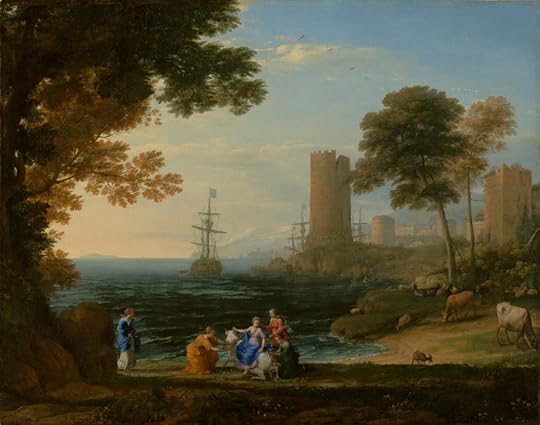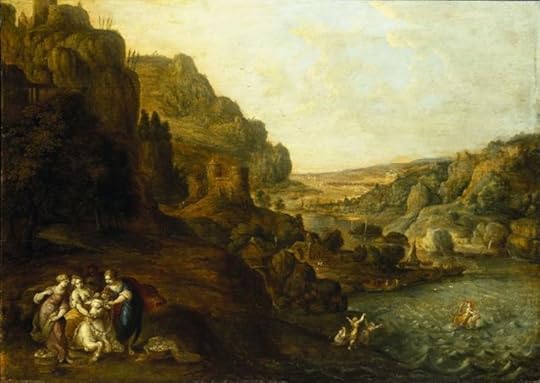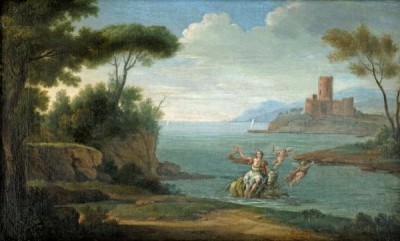 Kalliope’s
Comments
(group member since Aug 28, 2018)
Kalliope’s
Comments
(group member since Aug 28, 2018)
Kalliope’s
comments
from the Ovid's Metamorphoses and Further Metamorphoses group.
Showing 441-460 of 610
 In Actaeon's 'punishment' I see first of all a wish in Diana's part to prevent him from TALKING and telling others that he has seen her naked. Again the recurrent theme of the loss of speech. At least Io could write her name and make her father understand who she is. Had Actaeon being able to communicate, he would have saved himself - at least from being killed.
In Actaeon's 'punishment' I see first of all a wish in Diana's part to prevent him from TALKING and telling others that he has seen her naked. Again the recurrent theme of the loss of speech. At least Io could write her name and make her father understand who she is. Had Actaeon being able to communicate, he would have saved himself - at least from being killed. Mostly it is the female who have their speaking abilities taken away, but Actaeon is the second male (the first was Battus - who was turned into stone).
Then the being killed by his own dogs is a result of his dogs and companions not recognising him.
Juno, vindictive as she is, is delighted of this tragedy. She always turns against the victims, not the doer.
 To Steve and Jim - about the dogs...
To Steve and Jim - about the dogs...I had no problem with the enumeration of the dogs.. It made me think of oral traditions, and also that this work and its stories were addressed to a culture that enjoyed hunting and fights. Good dogs were precious and to be able to watch a pack of thirty plus dogs pushing themselves to the extreme must have been considered quite an spectacle.
Ovid is giving dimension to this scene by making it more concrete.
Actaeon's companions call him because they think he is missing quite something. And Actaeon himself would have liked to have been able to watch the kill - rather than suffer it.
 Roger wrote: "ACTAEON OPERA. Early on in Book III comes the story of Diana and Actaeon. This has special interest for me because I have done two productions of Actéon, the opera-pastorale written around 1680 by ..."
Roger wrote: "ACTAEON OPERA. Early on in Book III comes the story of Diana and Actaeon. This has special interest for me because I have done two productions of Actéon, the opera-pastorale written around 1680 by ..."Thank you Roger for your posts on the Charpentier opera... I will watch the YouTube recordings and come back... I may try to get the recording Jim mentions.
Incidentally, I have been reading lately and listening to other 17C music in relation to Casanova (I am reading his memoirs now and he talks about Lully and Rameau in his Preface) and Watteau (reading a couple of books on him), and considering various recordings for my Xmas stocking...
:)
 Jim wrote: "I've not yet discovered how to post pictures here on Goodreads as several of you have been doing. Too bad, this one is quite spectacular.).."
Jim wrote: "I've not yet discovered how to post pictures here on Goodreads as several of you have been doing. Too bad, this one is quite spectacular.).."Jim, for posting images, you need to do basically two things.
One is use the commands as indicated when you click (some html is ok) - I cannot type them now because they will work already as commands, but importan to use < to open and > to close as well as the inverted command.
And two, and the most tricky, is to get the internet address of the image you want to post. For this you need to put the mouse on top of the image and do a right click.. in the menu that will come up chose one of the following messages (the exact wording will depend on the Browser you use) - 'Copy Image address'; 'Copy Image Location'; . When you click on that option it will have already picked up its address. You then paste it into your comment in GR (framed by the html commands) and that should do the work.
Watch out that the image address does not look like a very long string of gibberish. If it does then the image is encrypted. You need to find the page where it is and try again to see wether you can get the non encrypted image.
The length and look of the non encrypted image address will look something like this:
https://studio360.files.wordpress.com...
I suggest you copy the above address (detail from an Acteon by Parmigianino) and try to 'frame' it with the html commands, and once you have mastered that first step you can then try with the addresses of other images you find and wish to post.
Good luck.
 Peter wrote: "
Peter wrote: "Whose words? Ovid's of course :-) Some of us have bilingual editions, i.e. Latin and their mother tongue (German in my c..."
Peter, in your edition, which Latin source is it using?
 Ce Ce wrote: "
Ce Ce wrote: "I now have the Simpson and Mandelbaum. I have read Book I Mandelbaum twice. Simpson in prose with remark..."
I think either RC or Elena may be able to clarify more about what Latin text do we have.
I agree with you, CeCe.. between the various textual versions of the various mythological stories and the various pictorial renditions, these Metamorphoses keep changing all the time.
 And related to the Northern landscape painters, since several of them spent time in Rome, we have Claude Lorrain. I am posting just two, but I believe he did a few more.
And related to the Northern landscape painters, since several of them spent time in Rome, we have Claude Lorrain. I am posting just two, but I believe he did a few more.Claude Lorrain. 1667. Royal Collection, UK.

Claude Lorrain. 1645. Getty.

 Here are a few renditions of the Europa episode but with the main focus on the landscape.
Here are a few renditions of the Europa episode but with the main focus on the landscape.The first is a Flemish painter. The other two are Dutch. My favourite is Minderhout's.
Jan Tilens. 1600-130. Alte Pinakothek, Munich.

Herman van Swanevelt. 1610-50. Holburne Museum, Bath.

Hendrik van Minderhout. 1696. Musée des Beaux-Arts de Rouen

 Roman Clodia wrote: " 'ideal-ecphrasis' ..."
Roman Clodia wrote: " 'ideal-ecphrasis' ..."On the 'ideal-ecphrasis', RC and Roger..
Remember the description of the doors in Hellios's palace when Phaeton arrives at the beginning of this book.
It is a beautiful description.
I posted on this above, #8.
 Roger wrote: "Roman landscapes that have come down to us..."
Roger wrote: "Roman landscapes that have come down to us..."These are wonderful details from Roman paintings, Roger, which reminds me that I was supposed to post some paintings from the Dutch landscapists.
I will do so later today.
 Roger wrote: "am so puzzled by the violence of the Ricci (#4) that I wonder if Europa is even the correct attribution.."
Roger wrote: "am so puzzled by the violence of the Ricci (#4) that I wonder if Europa is even the correct attribution.."roger, I was also puzzled by Riccio's Europa, and now that Fionnuala has picked it up and given a short dialogue to her, I have gone to look it up.
From the link below, which identifies a different source, an Ode by Horace, I am copying the relevant extract:
In the oft-depicted Ovidian version of the story however there is no mention of the pugnacious resistance apparent in the Budapest small bronze. In Ovid's Metamorphoses the princess was quite taken by the overtures made to her by Zeus turned bull. It is likely, then, that the author of the Budapest sculpture took inspiration not from this popular work, but from a less well known ode by Horace, in which the Roman poet writes of Europa's desperate protestations.
https://artsandculture.google.com/ass...
 Roger wrote: "I have been looking at a bunch of Europa sculptures. There is a wide range here, from heroic to Kitsch. But leaving aside the latter, one of the things that strikes me is how the stone or metal giv..."
Roger wrote: "I have been looking at a bunch of Europa sculptures. There is a wide range here, from heroic to Kitsch. But leaving aside the latter, one of the things that strikes me is how the stone or metal giv..."Thank you for the sculptures, Roger.
My favourites are: 1, 2, 8 and 10.
Alas, I am not fond of Botero...
:(
 Historygirl wrote: "I found the dolphins:
Historygirl wrote: "I found the dolphins:Europa: GreekMythology.com - Dec 03, 2018
“The bull laid down in front of Europa and she slid onto its back. Instantly, the bull charged off, plunging into the sea, and began..."
Thank you, Historygirl, when I read your quote I thought it could come from the Leucippe, but it must be yet another source.
 The text by Achilles Tatius can be downloaded very cheaply:
The text by Achilles Tatius can be downloaded very cheaply:https://www.amazon.com/Adventures-Leu...
The Europa passage is at the very beginning and it is short.
Several things strike me:
1. The ekphrastic quality which I mentioned above. This is a description of a painting of Europa, not the actual story. So what we have is Titian rendering back to painting a textual description of another painting and from the classical times.
2. Emphasis on the landscape. This would take us to the rendering by the Northern painters, with Rembrandt being one of them. Will look for more.
3. It does not correspond exactly to Titian, but the Dolphins and Cupids are there, with Eros himself taking a leading role and given an unequivocal romantic tone to the representation. No violence - just surprise.
In case not everyone downloads the book, I will give a quote:
.. her figure could be traced under the clothes -- the deep-set navel, the long slight curve of the belly, the narrow waist, broadening down to the loins, the breasts gently swelling from her bosom and confined, as well as her tunic, by a girdle: an the tunic was a kind of mirror of her body. Her hands were held widely apart, the one to the bull's horn, the other to his tail; and with both she held above her head the ends of her veil which floated down about her shoulders, bellying out through its whole length and so giving the impression of a painted breeze. Thus she was seated on the bull like a vessel under way, using the veil as a sail; about the bull dolphins gambolled, Cupids sported: they actually seemed to move in the picture, Love himself led the bull -- Love, in the guise of a tiny boy, his wings stretch out, wearing his quiver, his lighted torch in his hands: he was turning towards Zeus with a smile on his face, as if he were laughing at him for becoming a bull for his sake.
As said before, the Ambassador who was mediating in the negotiations of this commission, had a copy of this book. He came from a very literary family (in fact a portrait of one of his ancestors, a writer, figures on the cover of school textbooks on Spanish literature).
 Roman Clodia wrote: "
Roman Clodia wrote: "I did a tiny amount of reading on Titian and his Ovidian paintings, and remember being surprised t..."
But Titian hanged around with very literal people, Ariosto being a close friend.
In the correspondence with both Charles V and his son Philip II, Titian referred to the series of paintings the monarchs were commissioning as 'poesia' and 'fabula', thereby stressing the link between the plastic and literary arts, the creativity of the artist, and the disassociation of painting from the manual arts.
Checking material on the 'poesia' series in the Prado, they state that Titian's 'Europa on a Bull' was based mostly on the Leucippe and Clitophon, but they also stress that Titian would try to go beyond the text too, arguing for his own creative powers. (They stressed this particularly with another of the paintings in the series, the Venus & Adonis).
I have just downloaded it. I may read now just the Europa section and leave the rest for later.
 Well, the Rembrandt had more of a moral message and a particular one also - related to the patron who commissioned it.
Well, the Rembrandt had more of a moral message and a particular one also - related to the patron who commissioned it.For a good contrast we can now go to:
Boucher. 1732-34. Wallace Collection.

Look at the pampered Bull... Not altogether white. It is not just Europa enjoying the company of the animal.. all her companions are also delighted.
I am soon beginning to read Casanova's Memoirs, so I guess I'd better get used to Boucher's world.
 I have just finished reading The Rape of Europa: The Intriguing History of Titian's Masterpiece and he has an interesting passage.
I have just finished reading The Rape of Europa: The Intriguing History of Titian's Masterpiece and he has an interesting passage.He mentions another Greek text, The Adventure of Leucippe and Clitophon by Achilles Tatius. In this work there is ekphrastic description of a painting on Europa.
And I quote from Fitzroy:
What is interesting in his description of this painting is the number of details it contains which appear in Titian's painting: Europa's drapery blowing in the wind, and the cupids that accompany her, flying through the air and swimming in the sea.
The drapery blowing in the wind is in Ovid, but the cupids are not. I wonder about the Dolphins.
Then Fitzroy says that the Spanish ambassador to Venice, Diego Hurtado de Mendoza, and who mediated in the correspondence between Titian and Philip II, owned a copy of Achilles Tatius book.
May be RC knows about this..
I wonder about the dolphins. An important element and that Serov included.
So a painting based on a text about a painting...
 The Europa theme is inexhaustible.
The Europa theme is inexhaustible.Here is another very different rendition.
Rembrandt. 1632. J. P. Getty.

It was commissioned by a Member of the Dutch East India company. Hence the emphasis on the port, and this allegorical transport in the sea... Haha..
 Elena wrote: " I've just finished the biography of Rene Girard, a Stanford philosopher who considered Envy to be the driving force of human behavior, he..."
Elena wrote: " I've just finished the biography of Rene Girard, a Stanford philosopher who considered Envy to be the driving force of human behavior, he..."That sounds like a good book. I enjoyed the Envy episode in spite of everything. I counted about 12 times in which a term related to eyesight is mentioned.
I posted an image in Comment #107.
Another famous depiction of this Vice, but not related to Ovid is Giotto's in the Scrovegni Chapel.

 Roger wrote: "The Greeks have (or had) a relief of Europa and the bull on their 2 Euro coin. R.
Roger wrote: "The Greeks have (or had) a relief of Europa and the bull on their 2 Euro coin. R."
Yes, a bit ironic.. given what happened in 2012.

